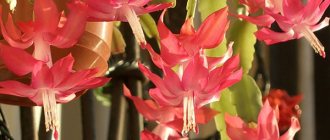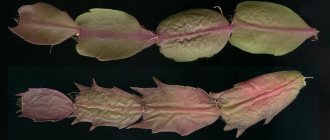Author: Elena N. https://floristics.info/ru/index.php?option=com_contact&view=contact&id=19 Category: Houseplants Published: January 18, 2019Last edits: January 11, 2021
- Why does the Decembrist wither
Decembrist is a cactus, but... “wrong.” Judge for yourself: there are no thorns, it loves humidity and does not tolerate direct sunlight, it refuses to bloom in drought... Experienced flower growers say that caring for a Christmas tree is more similar to caring for its exotic compatriot - the orchid, than for its prickly fellow cacti. In our latitudes, Schlumbergera blooms in winter, for which it received its “winter” names: Christmas tree, Decembrist. But with proper care, the Decembrist can bloom two or even three times a year.
- How to achieve such abundant flowering of the Christmas tree?
- Why does the Decembrist begin to fade?
- What to do if the leaves of the Decembrist fall off?
Our specialists know the answers to these and many other questions about caring for Schlumbergera.
Planting and caring for the Decembrist
- Flowering: in winter, December-January.
- Lighting: bright diffused light or light partial shade (eastern or western windows, the southern window should be shaded in the afternoon).
- Temperature: possible range from 18 to 40 ˚C, but in summer the plant is comfortable at 18-22 ˚C, in winter – at 14-16 ˚C.
- Watering: moderate, after drying the substrate to a depth of 1-3 cm.
- Humidity: high. Regular spraying is recommended up to several times a week in summer and 1-2 times a month in winter.
- Feeding: from March to September once every two weeks with complex mineral fertilizer for cacti.
- Dormant period: October-November.
- Transplantation: young plants are replanted every 3 years, adults - once every 5-6 years.
- Trimming: the crown is shaped by pinching off excess segments with your hands.
- Reproduction: vegetative (by grafting or cuttings).
- Pests: scale insects, spider mites, mealybugs.
- Diseases: late blight, phytium, fusarium, damage by bacteria of the Erwinia group.
Read more about growing Decembrist below.
It’s hard to believe, but in nature there are cacti that love water, are afraid of the sun and do not have thorns, and they are called Decembrists (lat. Schlumbergera) , or Schlumbergers , or zigocacti . They belong to the genus of South American epiphytic cacti that grow in tropical forests on tree branches. Why are they called Decembrists? Yes, because they begin to bloom at the height of the tropical summer - in November-December, and end at the end of January. Zygocacti were brought to our latitudes by collector Allan Cunningham in 1816.
Fertilizers for the Decembrist - the path to flowering
What needs to be done for the Decembrist to bloom? In addition, as described below, it is also important to periodically fertilize the soil in the flowerpot. This will give the plant additional nutrition.
How to feed the Decembrist so that it blooms? The choice of fertilizer depends on the time of year. How to water Decembrist in spring and summer? During this period, it is important that the branches and leaves of the flower grow. For this purpose, nitrogen fertilizers are used. They provoke the growth of deciduous mass. You can refill them until the end of summer. You can also use fertilizers intended for cacti. True, to water the Decembrist, the concentration in them should be reduced. But with the arrival of autumn, you should stop giving the flower fertilizer, as it will rest throughout this season. As soon as the buds appear on the Decembrist plant, move on to a new series of fertilizing. How to fertilize the Decembrist plant to bloom? You can apply any fertilizer except nitrogen. This is important because during the flowering period the plant does not need to grow new stems. If you do not follow this advice, then you can achieve that the Decembrist will grow a lot, will be simply huge, but will not bloom.
It is impossible to do without fertilizers completely. The soil becomes poorer over time, and in indoor conditions its nutritional qualities cannot be restored naturally. Therefore, the only way to somehow solve the problem is fertilizers. With them, plants can exist as they should.
After the Decembrist has finished flowering, again give it at least a minimum period of rest. At this time, do not disturb it with fertilizers and frequent watering. All this will resume in early spring.
Now that you know what to feed the Decembrist to bloom, you can safely do it.
Photo from website: m.ok.ru
Features of the flower
All plants have their own characteristics. The main feature of the Decembrist is that it blooms when other flowers are resting. But he also has other qualities that distinguish him from all the other inhabitants of your windowsill.
- Caring for begonia at home - difficulties
- Firstly, the Decembrist is uncomfortable on southern and western window sills, since intense lighting can cause the terminal segments of the plant shoots to die off.
- Secondly, in the summer, the Decembrist, like no other indoor plant, needs fresh air: a shaded place on a balcony, loggia, or terrace is suitable.
- Thirdly, in the summer, the Decembrist likes to take a shower, but if this is not possible, then at least spray it from time to time.
- Fourthly, with good care, a long-lived Decembrist can congratulate you with his bouquet on the New Year for about 15-20 years.
- Fifthly, the Decembrist flower is one of those capricious plants that cannot be disturbed at the moment of budding - rearranged from place to place and even turned the pot with the plant.
- Sixthly, Decembrist can be grown as an ordinary plant, or as an ampel plant.
You will gradually learn about other features in the following sections of the article.
Signs and superstitions
All signs associated with the early flowering of Schlumbergera promise good luck and an improvement in the financial situation in the family for the entire next year.
When a cactus blooms on time for a creative person, it promises the owner new horizons in his work.
The lush bloom of a cactus is associated with a lot of positive emotions in the house. But this does not mean that the Decembrist flower is a donor or a vampire. Simply, the happier the people in the house, the more care they give to the plant. And it responds to love with abundant flowering.
The variety of Decembrist varieties allows you to choose specimens that meet the tastes of each cactus grower. And its unpretentiousness and ability to adapt make it possible to grow this plant in the collections of beginners. The main thing is to follow care regimens and treat your pets with love.
Caring for the Decembrist at home
Rules of care
The agricultural technology of the Decembrist zygocactus is directly opposite to the agricultural technology of cacti themselves; their requirements for the most part coincide with the conditions for growing ordinary, deciduous indoor plants.
If the cactus can be forgotten to water, and it will not suffer much from this, then the Decembrist needs regular watering with settled, non-cold water and increased air humidity, which is achieved by regular spraying or placing the pot with the Decembrist on a tray with wet pebbles. Cacti tolerate the sun well, but Decembrist suffers from direct sunlight and requires shading.
As for air temperature, the Decembrist is not capricious in this matter. Since March, the Decembrist needs monthly fertilizing with complex fertilizer for flowers, but the dose must be taken half as much as suggested by the manufacturers. In the summer, when intensive growth of stems begins, the plant needs to be fed twice a month, and from September, feeding should be stopped. Preventative treatment with fungicides will not harm the plant.
In the photo: Young Decembrist on the windowsill
How to trim
Decembrist pruning is carried out in June, and the excess part of the shoot is not cut off, but unscrewed by hand, giving the plant a beautiful shape, shortening shoots that are growing incorrectly. Plants formed in this way have an attractive appearance and bloom more abundantly.
About another winter-blooming flower - the Christmas star
- Dipladenia (Mandevilla): home care
How to transplant
The Decembrist is transplanted after flowering, at the very end of February. Young plants are replanted annually, adults - once every 4-5 years. Choose a wide and low pot for the plant, since the Decembrist’s root system is superficial. The drainage layer should fill the pot by a third. As for the soil, store-bought cactus soil is suitable.
You can make the soil yourself: mix one part each of turf soil and sand and two parts leaf soil, add crushed coal for disinfection, and for better water permeability – brick chips or expanded clay. The soil for Decembrist should be slightly acidic.
Difficulties and problems of cuttings
When taking cuttings you may encounter some problems:
- the leaf segments turn red - this is probably due to direct sunlight on the young plant;
- the cuttings wither - this occurs due to violation of the rules for caring for the plant (watering and spraying with cold water, excess fertilizing) or the development of a fungal infection;
- the cutting is rotting - most likely the problem is an excessive amount of moisture; it is necessary to remove the cutting from the soil, remove the damaged parts, dry it for 48 hours and plant it in new soil, reducing watering.
Reproduction of the Decembrist
The answer to the question “how to propagate Decembrist?” very simple: vegetatively, by cuttings. 2-3 outer “links” are unscrewed from the shoot, dried for several days, then planted in moist soil and covered with a glass jar or plastic bottle to create a greenhouse effect. The container is placed in the shade and ventilated regularly. The optimal temperature for rooting Decembrist cuttings is 15-20 ºC. Christmas trees are often propagated at home immediately after pruning, since as a result of the formation of the bush, ready-made material remains for cuttings.
In the photo: Rooting Decembrist cuttings
Pests and diseases
The Decembrist is plagued by fungal diseases and insects. Fusarium, phytium and late blight are fungal diseases, the pathogens of which penetrate the plant from contaminated soil, and the root collar of the plant is the first to suffer from them. As a result, the flower becomes pale, gray, loses segments and withers in moist soil.
Fusarium is treated with fungicides, and phytium and late blight are treated with Maxim, Topaz, Vitaros.
If the plant is covered with a rusty coating, then, most likely, it was affected by spider mites - small pinpoint insects of brown, yellow or reddish color that appear on the plant in conditions of insufficient air humidity. The drugs Actellik, Fitoverm or Neoron will help get rid of the tick.
Whitish lumps that suddenly appear between the shoots, similar to cotton wool, are traces of the vital activity of mealybugs, which can be neutralized with the help of Aktara.
- Syngonium flower in the photo
Why does the Decembrist wither
The Decembrist withers, as we have already found out, if he is sick with late blight or phytium. Another reason for leaf wilt may be root disease. If the plant has lost its stability and its trunk is swaying, then it is quite possible that the roots of the plant died from hypothermia as a result of watering with cold water in a cool room or, conversely, from the fact that the flowerpot overheated in the sun.
A too strong concentration of fertilizers could also burn the roots of the Decembrist. In this case, the plant must be immediately transplanted into another substrate, because the old one is saturated with concentrated fertilizer, which continues to destroy the roots.
Why does the Decembrist not bloom?
The Decembrist must feel when it is time to bloom. To do this, it needs to be provided with a full rest period: from the end of September to the end of November, reduce watering and stop feeding the plant, placing it in an unheated room.
Now remember how to make the Decembrist bloom: move the flower to a bright, warm place and start watering, thereby helping the Decembrist to wake up. Rotate the plant around its axis to achieve uniform illumination on all sides of the flower. As soon as buds begin to form, make sure that the substrate in the pot does not dry out and that no one else in the house moves or turns your flower, otherwise the plant may panic and drop the buds.
If you follow these rules, your Decembrist will definitely bloom.
Why does it fall
Sometimes, seemingly for no reason at all, the leaves of the Decembrist fall off. But nothing just happens. Let's try to figure it out.
It is known that the cause of “leaf fall” can be a spider mite, and you already know how to get rid of it. If you do not find the pest, then the likely cause may be a lack of nutrients (irregular feeding, depleted substrate). Try spraying Decembrist once or twice with a solution of fertilizers for epiphytic cacti or apply it at the root, and you will see how quickly the plant will regain its strength. If it doesn't help, change the soil.
The reason for the fall of the final segments may be too dry air or stress suffered by the plant - a sharp temperature change, a change in the environment, a draft, or a transplant done at the wrong time.
In the photo: Blooming Decembrist
Step-by-step instructions on how to root Schlumbergera
To separate the selected cutting, you need to pinch it with your fingers and, turning clockwise, carefully unscrew it from the mother plant, holding the branch with your other hand.
Under no circumstances should you use scissors, a scalpel, a knife or any other sharp objects, otherwise the planting material may be damaged.
The separated cutting must be dried for 48 hours by placing it on a napkin and putting it in a dark place, after which a thin film will appear on the detached area.
For rooting there are 2 equal options: in soil and in water.
In water
It is necessary to place the cutting in water at room temperature so that it covers 1 of its segments. If the water level drops, it should be added. It is important to monitor the condition of the water: if it becomes cloudy, it must be replaced immediately and the cuttings must be washed to avoid the possibility of rotting.
The roots appear after 7-14 days ; you can speed up this process by adding a few “Kornevin” to the water.
When the roots reach a length of more than 2 cm, the cuttings need to be transplanted into the ground.
Important! The water used must stand for at least 24 hours so that chlorine and its derivatives are removed from it, otherwise the young zygocactus may die.
In the ground
You need to thoroughly wash and disinfect the container for planting the cuttings, add a drainage layer and prepared soil to the bottom. Next, you should water the soil and vertically deepen the cutting into it by about 5 mm.
If a large pot is chosen as a container for planting, 2-4 cuttings should be planted in it, if a plastic cup - 1.
It will take about a month for the zygocactus to take root in the soil . To speed up the growth of roots, “Kornevin” is used - you should dip a cut of the shoot into it before planting.
FAQ
Why doesn't the Decembrist bloom? The cause of the problem may be that the container is too large, and the plant will not bloom until its roots have taken over the entire space of the pot.
Sometimes the Decembrist refuses to bloom because the soil is not suitable for it. But usually the lack of flowering means that the plant does not have the necessary conditions for rest. At the end of September, move the Decembrist to a cool room, gradually reduce watering until it stops completely and do not fertilize. At the end of November, return the plant to its usual place and gradually resume the usual moisture regime.
The pot with the plant should be slightly rotated around its axis every day so that all shoots receive the same amount of light and develop evenly. But once bud formation begins, the plant cannot be moved or rotated, otherwise the Decembrist will drop the buds.
Keep the potting soil slightly moist.
If you do everything correctly, the Decembrist will definitely bloom. Why are there white spots on the Decembrist?
White spots on the segments of the Decembrist may appear from watering the plant with too cold water. Do not forget that indoor flowers need to be watered with settled water at room temperature, and some plants even require slightly warmed water.
White spots may appear on Decembrist leaves in winter if your windows have curtains that are too thick and do not allow room heat to reach the plant standing on a cold windowsill. Move the Decembrist to a warmer place, water it with Epin’s solution, and the plant will gradually warm up. While Schlumbergera is recovering, watering should be sparse. To prevent the Decembrist’s roots from freezing in the future, place a foam circle under the pot.
Mealybugs can also be mistaken for white spots, which can be gotten rid of with an insecticide, but you must first remove the pests from the leaves using a cotton swab, wash the Decembrist with warm water and allow it to dry.
The Decembrist is not growing - why?
The Decembrist generally takes a long time to grow, and if you have created all the necessary conditions for him, but he is in no hurry to develop, there is no need to worry. Decembrist loves cool air, so place it under a window so that when ventilating, fresh air from the street flows onto the plant, but there should be no drafts in the room.
You can stimulate the growth of the Decembrist with the help of a warm shower: wash the plant with warm, settled water once a week, and the result will not be long in coming. Make sure that the soil in the plant’s pot does not dry out and apply fertilizer in a timely manner.
Do not keep Decembrist in the kitchen: the temperature in this room often changes, and this instability has a bad effect on the plant.
And don’t forget about regular replanting: young Decembrists need to change the container and substrate once a year, and adults – once every five years. This plant needs a low but wide pot, since its root system is superficial. How to cut an overgrown Decembrist haircut?
To make the Decembrist look attractive, it needs to be pruned, and this should be done in the first month of spring, when the plant enters a period of active growth. You can carry out the procedure at another time, but not earlier than a month after the end of flowering: cutting during the formation of buds and flowers will lead to the Decembrist dropping them and will not bloom this year.
Pruning not only gives the Decembrist a well-groomed appearance, but also stimulates abundant flowering and also prolongs the life of the plant. Actually, although this process is called pruning, it is actually carried out manually: you simply pinch off with your hands those segments that seem unnecessary to you. Using any sharp instrument can harm the plant.
Hold the lower segment with one hand and use the other to turn the upper segment clockwise until it separates.
The segments remaining after pruning can be used for propagation. How often to replant Decembrist?
Transplanting Decembrist is a mandatory procedure that prolongs the life of the plant. Young Decembrists should be replanted every year, and starting from the age of four - once every four years. A plant that is not transplanted in due time will begin to wither, wither, and eventually die.
The best time for replanting is spring, when Schlumbergera begins a period of active growth. Observe the plant, and as soon as young segments begin to appear on it, you can begin replanting.
The pot for the Decembrist should not be deep, since the roots of this plant are superficial, but the container must be stable and wide enough.
Drainage material should occupy at least a third of the volume of the pot. Store-bought soil for cacti is suitable as a substrate, but you can make a soil mixture yourself from equal parts of leaf soil, sand, turf soil, adding a quarter of humus to it. Why does the Decembrist shed its buds?
This usually happens if the flower pot is turned or moved from place to place during bud formation. The plant cannot be moved at this time. But sometimes the loss of buds is caused by the wrong location or improper conditions.
We remind you: the best place for a zygocactus is an eastern window, but if your windows face west or south, be sure to shade the Decembrist with a curtain from bright sunlight, because you are dealing with a forest cactus that prefers diffused light.
Do not expose the Decembrist to sudden temperature changes and do not keep it in a draft.
The plant's dormant period should be cool at 12-16 ⁰C. During the period of active growth, the plant is comfortable at a temperature of 18-24 ⁰C, and when flowering begins, it is advisable to lower the temperature to 18-20 ⁰C. The heat is not conducive to Decembrist flowering, so in winter, protect it from the hot air coming from heaters. How to water and fertilize Decembrist so that it blooms?
From November to February inclusive, the Schlumbergera soil should be moistened weekly, and so much so that the earthen ball is soaked through with moisture. Actually, the frequency of watering depends on the conditions of maintenance: in a warm room you will have to water more often, but in a cool winter the soil dries out much more slowly. Watering is carried out when the substrate in the pot dries to two-thirds of the depth, and the shoots of the plant begin to wrinkle. The water should be no colder than room temperature, and it should be left for at least a day.
As soon as the buds begin to form, add fertilizer to the soil once every 2-3 weeks, but be careful: it is better not to fertilize the Decembrist at all than to overfeed it.
For abundant flowering, Schlumbergera requires calcium and phosphorus.
The best choice is fertilizer for flowering plants or a complex for cacti and succulents. Sometimes water the soil with a solution of 1 teaspoon of castor oil in 1 liter of water. The Decembrist has limp leaves - what to do?
The reasons for this unpleasant phenomenon can be: the plant is affected by a disease or its roots die for some reason. The most dangerous diseases are fusarium, late blight and phytium. These fungal infections prevent the Decembrist leaves from supplying moisture, which is why they become lethargic and soft.
Pay attention to the root collar of the plant and if damage is detected, immediately begin treatment. If the pathology has not yet affected the roots, the plant can be saved with Fitosporin-M, Maxim, Topaz or Skor. But if the soil is infected with a fungus, the plant will have to be replanted. When replanting, pay attention to the roots and get rid of rotting areas.
If the wilting of the leaves is caused by the death of the roots, replanting the plant will not save it.
The only thing you can do is to take Decembrist cuttings and grow a new plant from its segments: Schlumbergeras take root easily even in flaccid segments. Is it possible to grow Decembrist from an almost withered leaf?
Reproduction of Decembrist by segments is the simplest and therefore the most popular method. Even a flaccid segment of the stem is suitable for this. There have been cases when a dried segment lying in a bag successfully took root.
It is necessary to separate the segment for propagation when the Decembrist plant is not blooming, otherwise the plant may behave as if in a stressful situation: it will begin to shed flowers and buds. Before planting, the cutting should lie in a dark place for two days.
It is still desirable that the cuttings consist of 2-3 segments: longer cuttings are inconvenient to work with. Part of the stem is planted in loose peat-based soil, the pH of which should be in the range of 5-6.5 units. As a container, you can use a plastic cup or pot with a volume of up to 200 ml. The dishes must have drainage holes.
Place a layer of perlite, expanded clay or other drainage material on the bottom of the cup, fill the container with substrate and stick the cutting into it.
Is Decembrist dangerous for pets and children?
Decembrist is not a poisonous plant, so it is not dangerous for children. But in pets that chew the leaves of the plant, swelling of the larynx or indigestion may occur, and in people suffering from asthma, Schlumbergera can cause breathing difficulties.
Neither official nor traditional medicine has discovered healing properties in Decembrist, but it purifies the air from harmful chemicals emitted by interior items made of plastic and synthetics, and saturates the room with oxygen. In addition, the Decembrist absorbs electromagnetic radiation.
This plant is simply intended for a psychologist’s office: it makes people want to communicate and share their secrets.
Astrologers claim that zygocactus is able to extinguish aggression and helps get rid of bad intentions. However, women are not recommended to keep this flower in the house, since there is an opinion that it belongs to the category of “husband-killers”. How to divide a Decembrist plant?
Typically, Decembrist is propagated by cuttings, but an overgrown bush can be divided into parts and immediately obtain at least two adult plants. Division is carried out simultaneously with transplantation or at any time after the end of the flowering period, but the best season for this procedure is spring.
Remove the Decembrist from the pot, remove old and flabby shoots, carefully untangle the roots, cut the rhizome with a sharp sterile knife, sprinkle the sections with charcoal powder and plant the cuttings in different pots with fresh loose soil.
Sometimes, when the rhizome is exposed, you can find rotten areas on it. Carefully cut out the rot, grabbing healthy tissue, treat the wounds with a solution of fungicide or potassium permanganate, and only then divide the root and plant the divisions.
It is likely that after this painful procedure, the Decembrists will be sick for some time, but eventually they will adapt and begin to develop.
How to restore a frozen Decembrist?
Decembrist is a tropical plant, so prolonged exposure to temperatures of 16 ⁰C and below can lead to irreversible consequences. If the shoots of a frozen Decembrist have not yet become watery, it can be saved, but in this case it is very important not to change the conditions of the plant too abruptly: this will cause it even more harm.
Place the Decembrist in a bright room in which the temperature does not rise above 18 ⁰C, and prevent the appearance of drafts. Provide bright, diffused light, spray with Epin solution, but under no circumstances water the plant. Over time, the Decembrist will come to life, and fresh segments will begin to appear on it, and then buds.
But if the roots of the plant have already died from the cold, try to save it by rooting cuttings separated from the stems, 2-3 segments long. You can root the segments in water (the roots grow within two weeks) or directly in soil for cacti and succulents.
Popular types and varieties of Zygocactus
In indoor culture, according to GRIN - Genetic Resources Information Network, gardeners breed 9 main species of Schlumbergera. These species are the basis for the breeding work of cactus growers all over the world; on their basis, a large number of varieties and hybrids of Zygocactus have been created. Research by specialists is ongoing, thanks to which new varieties of this sought-after plant continue to be registered every year.
Photos help to identify some features of the main varieties of Decembrist.
Buckley
The most common Dekabrist variety, characterized by an increased ability to adapt to care and special resistance to diseases and pests. Can be grown as a hanging plant.
The cactus grows up to half a meter in height, has soft segments of stems of a dark shade of green, which become coarser at the base as the plant matures. The flowers are large, tubular in structure, painted in different tones of pink and lilac.
Schlumbergera Buckley has a long flowering period: from late autumn to March.
Schlumberger truncated
This variety is one of the basic ones for breeding. The height of the plant does not exceed 0.5 m. Both erect and hanging forms are cultivated.
Decabrina is distinguished by small light segments with sharp notches along the contour. The flowers are large, with curved petals, painted in various shades of crimson, less often in other tones.
Kautsky
The Decembrist variety, reminiscent of Sh. truncated - at one time these varieties were considered related subspecies. But due to its smaller dimensions, Kautsky’s Decembrist has been relegated to the category of an independent species.
It is distinguished by the purple tonality of its buds.
Microcylindrical
This succulent is distinguished by the cylindrical shape of all segments. The color of the buds varies from white to lilac shades.
The plant begins flowering in March.
Rousseliana
A low variety of Decembrist (about 30 cm), which is capable of growing long, almost meter-long, creeping stems. It is characterized by increased resistance to adverse conditions.
The plant blooms from February to April, producing many pink buds.
Orsichiana
A peculiarity is the color of the corolla petals with a noticeable color transition from reddish at the edges to white-pink in the center .
Able to form buds 3 times a year: March – August – November.
Opuntia
The succulent belongs to a variety rarely found in collections. A characteristic feature is the presence of white areoles with long spines, due to which the Decembrist segments resemble the stems of Opuntia.
The stems can reach more than a meter in length. It blooms in spring with large corollas of pink-violet shades.
The distinctive features of Decembrist varieties and hybrids can be seen in the photographs below.











